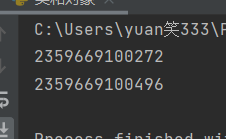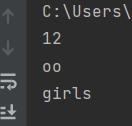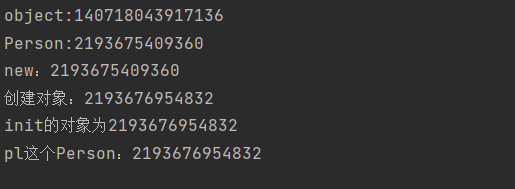python的类和异常捕获
python基础的终结
- 面向对象
- 面向对象知识补充
- 类的基本属性
- 类的应用
- 异常捕获
面向对象
基本概念
对象:
是可以存放数据和功能的容器,也是数据和功能的函数
类:
多个对象相同数据与功能的结合体,类的产生是为了减少代码冗余 核心还在于对象
eg: 对象1: gender='male' hobby='basketball' name ='jj' 对象2: gender='male' hobby='basketball' name ='bb' 对象3: gender='male' hobby='basketball' name ='kk' # 代入类: 对象1: name ='jj' 对象2: name ='bb' 对象3: name ='kk' 类: gender='male' hobby='basketball'
**在程序中需要先定义类 之后才能产生对象**
语法: # class 定义类关键字 # 类名称为英语,首字母推荐大写 class 类名称: # 缩进 # 对象的相同功能或数据 数据 def 函数名(self):
pass '''
在类中定义的数据和方法统称为属性
在类中定义的函数被称为:方法 '''
面对对象编程
eg:
class Student: # 相同的数据 school = '北京大学' # 相同的功能 def choose_course(self): pass # 定义对象 # 每次定义都是一个新的对象 per1 = Student() print(id(per1)) per1 = Student() print(id(per1))

per1 = Student() print(per1)) per1 = Student() print(per1))

访问数据和功能
# 衔接上述代码 per2 = Student() per3 = Student() # 查看内部所有的属性和方法 print(Student.__dict__) print(per1.__dict__)

# 调用属性和方法(句号) print(per2.school) print(per3.choose_course()) print(per2.choose_course())

1.形参self到底是谁
新参self用于指代使用该类的每一个对象
2.为什么对象调用类的时候,形参self不需要传值
对象在调用类里面定义的方法的时候,程序会自动将对象传入self位置
对象的独有数据
class Student: # 相同的数据 school = '北京大学' def __init__(self,name,age,hobby): self.name = name self.age = age self.hobby = hobby # 相同的功能 def choose_course(self): print('体育') # 定义对象,给对象赋予独特属性 per1 = Student('jj',12,'girl') per2 = Student('hh',23,'girls') per3 = Student('oo',70,'porn') # 调用属性和方法(句号) print(per1.age) print(per3.name) print(per2.hobby)

面向对象知识补充:
父类
多个类相同的数据和功能的结合体
继承:
类可以拥有其父类的所有功能

# python与其他语言不同的一点,一个类可以有多个父类,

对象查找顺序:
先从自身开始找,再去产生对象对应的类里面找,再去父类找(就近原则)
1.自身找
eg: # 父类 class Dad: age = 111 # 子类 class Son(Dad): age = 23 def __init__(self,age):
self.age = age
# 对象
per1 = Son(12)
print(per1.age)
'''
输出为12
'''
2.对象对应的类
eg: # 父类 class Dad: age = 111 # 子类 class Son(Dad): age = 23 # 对象 per1 = Son() print(per1.age)
'''
输出为23
'''
3.在父类找
# 父类 class Dad: age = 111 # 子类 class Son(Dad): pass # 对象 per1 = Son() print(per1.age)
'''
输出为111
'''
类的封装
封装:用于提高程序的安全性
使用方法:在类内部的属性前加上“--”,表示类只能在内部使用,只有特殊应用可以使用
class car: def __init__(self,brand,chang): self.__chang=chang self.brand=brand def start(self): print(self.brand,self.__chang) new=car('大众',3) new.start() print(new.brand) print(new.__chang)

可以看见“__chang"无法在外部应用。
# 如果要成功输出3,需要执行改操作 print(new._car__chang)

类中__str__的运用
class car: def __init__(self,brand,chang): self.__chang=chang self.brand=brand def stu(self): return '我是啊{0},这是{1}'.format(self.brand,self.__chang) new=car("学生",3) print(new)

输出为存储的地址
class car: def __init__(self,brand,chang): self.__chang=chang self.brand=brand # 将之前的进行替换 def __str__(self): return '我是啊{0},这是{1}'.format(self.brand,self.__chang) new=car("学生",3) print(new)

类的一些基本性质
class A: pass class B: pass class C(A,B): def __init__(self,name,age): self.name=name self.age=age x=C('JACK',23)
__dict__
# 对象的属性字典 print(x.__dict__)

__class__
# 输出对象所属的类 print(x.__class__)

__bases__
# 输出C类的父类型的元素 print(C.__bases__)

__mro__
# 输出C类的层次结构 print(C.__mro__)

__subclasses__()
# A的子类列表 print(A.__subclasses__())

类的应用
__add__():
class car: def __init__(self,chang): self.__chang=chang # 创建方法将对象内容相加 def __add__(self,A): return self.__chang+A.__chang new=car("学生") one=car("车子") # 进行相加 s=new+one print(s)

__len__():
class car: def __init__(self,name): self.name=name # 创建 def __len__(self): return len(self.name) new=car("学生") s=new.__len__() print(s)

__new__():
class Person(object): # 创建新对象 def __new__(cls, *args, **kwargs): print("new:{0}".format(id(cls))) obj=super().__new__(cls) print('创建对象:{0}'.format(id(obj))) return obj # 调用对象 def __init__(self,name,age): print("init的对象为%d"%id(self)) self.name=name self.age=age # 输出对象的存储位置 print("object:%d"%id(object)) print("Person:%d"%id(Person)) # 实行创建 pl=Person("张三",20) print('pl这个Person:%d'%id(pl))

异常捕获

异常的分类
1.语法错误
不被允许的 不应该出现,后果很严重,老板发现可能让你直接提桶跑路
2.逻辑错误
可以允许发生的(bug)
语法: try: 被检测的代码 except 错误类型 as 变量名: 分支代码(变量名指代的就是错误的具体信息) ''' 万能错误类型Exception/BaseException '''
万能错误类型Exception/BaseException
eg: class Son(): age = 23 def __init__(self,age): self.age = age try: per1 = Son() except Exception as f: print('有错误') ''' 输出 有错误 '''
异常捕获的使用建议
- 异常捕获在程序中尽量少用
- try检测的代码尽量少
其它关键字
else
在try被检测的代码没有异常的情况后执行
eg: class Son(): age = 23 try: per1 = Son() except Exception as f: print('有错误') else: print('没错') ''' 输出 没错 '''
finally
始终回执行不管有没有异常
class Son(): age = 23 def __init__(self,age): self.age = age try: per1 = Son() except Exception as f: print('有错误') finally: print('执行') ''' 输出: 有错误 执行 '''
